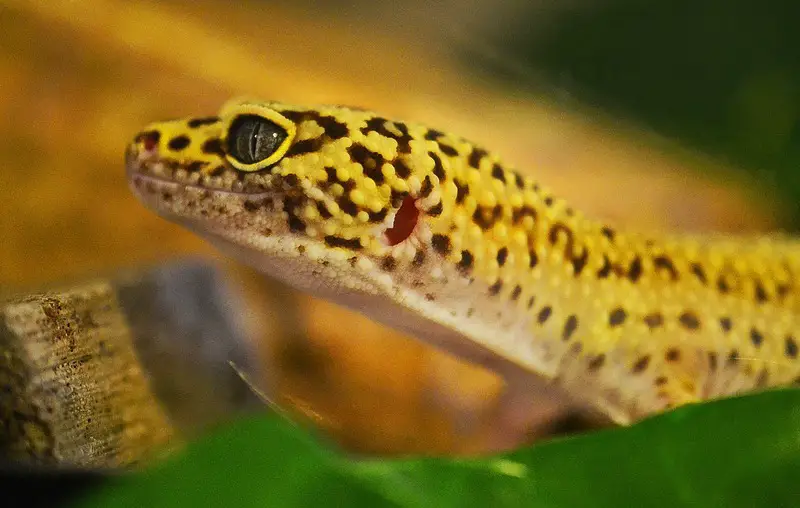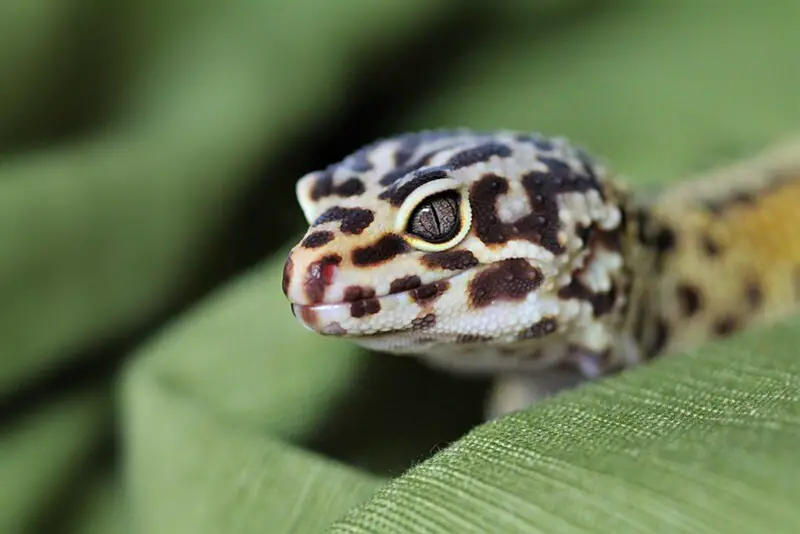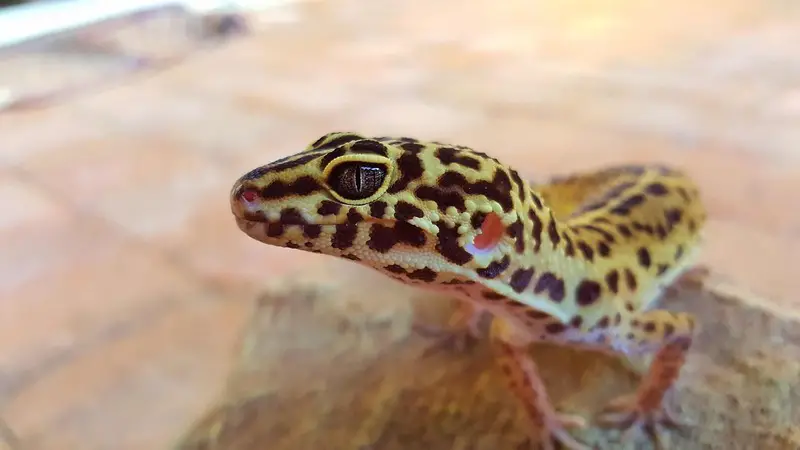Leopard geckos are native to arid regions in South Asia and are well-suited to captivity. However, many questions surround their sensory abilities, including their capacity to perceive and respond to colors. In this comprehensive exploration, we will delve into the intriguing world of leopard gecko vision and attempt to answer the question: Can leopard geckos see color?

Understanding Leopard Gecko Vision
To understand the visual capabilities of leopard geckos, we must first recognize their natural habitat and behaviors. In the wild, leopard geckos are nocturnal creatures, meaning they are primarily active during the night. Their visual system has evolved to cater to their specific lifestyle and ecological niche.
Nocturnal Vision
Leopard geckos, like many nocturnal animals, have adapted to low-light conditions. Their eyes have several features that enable them to see in the dark:
- Rod Cells: The retinas of leopard geckos, like those of most nocturnal animals, are rich in rod cells. Rod cells are photoreceptor cells that are highly sensitive to low light levels, making them well-suited for nocturnal vision.
- Tapetum Lucidum: Leopard geckos, like other nocturnal animals, possess a tapetum lucidum, a reflective layer behind the retina. This layer reflects incoming light back through the retina, allowing it to be absorbed by the photoreceptor cells twice, enhancing the ability to detect low levels of light.
- Vertical Slit Pupils: Leopard geckos have vertical slit pupils, which can constrict to narrow slits in bright light and expand to larger circles in low light. This helps regulate the amount of light entering the eye, allowing them to see more effectively in varying light conditions.
- Keen Sense of Smell: While their vision in low light is impressive, leopard geckos also rely on their sense of smell to locate prey and navigate their environment.
Color Vision in Nocturnal Animals
Nocturnal animals, including leopard geckos, typically have limited color vision. Their vision is predominantly monochromatic or dichromatic, meaning they primarily perceive shades of gray, and in some cases, blue or green. The reduced color vision is an adaptation to their low-light environment, where color differentiation is less important compared to brightness and contrast.
Leopard Gecko Retina
The retina of a leopard gecko is composed of various types of cells, including rod cells for low-light vision and cone cells for color vision. While cones are responsible for color vision, they are less numerous in the retinas of nocturnal animals, including leopard geckos, compared to rod cells. This suggests that while leopard geckos may have some color vision, it is likely less developed and less important to their overall visual perception.

Experiments on Leopard Gecko Color Vision
To gain a better understanding of leopard gecko color vision, researchers have conducted experiments to assess their ability to discriminate between colors. These experiments provide valuable insights into the extent of their color vision capabilities.
Cone Cells and Color Perception
As mentioned earlier, color vision is typically associated with the presence of cone cells in the retina. These cone cells are sensitive to different wavelengths of light, allowing for the perception of color. While cone cells are present in the retinas of leopard geckos, they are less abundant than rod cells, indicating that color vision may not be highly developed in these nocturnal reptiles.
One experiment involved training leopard geckos to associate different colors with specific rewards. In this experiment, leopard geckos were presented with two differently colored shelters, one of which contained food. Over time, the geckos learned to associate a specific color with food, demonstrating their ability to differentiate between colors to some extent. However, the study noted that their color discrimination was not as precise as that of animals with well-developed color vision.
Color Preference and Aversion
In another study, researchers investigated leopard gecko color preference and aversion. The geckos were exposed to various colors and their responses were observed. While the results suggested that leopard geckos had some degree of color preference, it was not clear whether their responses were based on the colors themselves or on the contrast between the colors and the background.
Overall, these experiments indicate that leopard geckos may possess some limited ability to perceive and differentiate between colors. However, their color vision is likely not as sophisticated as that of diurnal (day-active) animals with well-developed color vision.
Dichromatic or Monochromatic Vision
The question of whether leopard geckos have dichromatic or monochromatic vision remains a subject of debate. Dichromatic vision implies that they can perceive two primary colors and their combinations, while monochromatic vision means they perceive only shades of gray. Given their predominantly nocturnal lifestyle, it is more likely that leopard geckos have monochromatic or dichromatic vision, with the ability to perceive a limited range of colors, such as blue and green, rather than the full spectrum of colors visible to humans.
Evolutionary and Ecological Factors
The limited color vision of leopard geckos can be attributed to their evolutionary history and ecological niche. Nocturnal animals, in general, have evolved to prioritize visual sensitivity under low-light conditions rather than color discrimination. The adaptations that enable them to see in dim light, such as the tapetum lucidum and a preponderance of rod cells, come at the expense of detailed color vision.
In the case of leopard geckos, their natural habitat and behavior have shaped their visual system. In their arid, rocky environments, color differentiation may be less crucial for survival and reproduction compared to their ability to detect prey and predators in low-light conditions.

Implications for Captive Husbandry
Understanding the visual capabilities of leopard geckos has implications for their care in captivity. While their color vision may be limited, their overall visual perception is well-suited to their nocturnal lifestyle. Here are some considerations for leopard gecko husbandry based on their visual capabilities:
- Substrate Color: When selecting substrate or decor for the terrarium, it’s essential to choose options that provide contrast and allow leopard geckos to navigate their environment effectively. Substrates in various shades of gray or earthy tones are suitable.
- Diet Presentation: Leopard geckos primarily rely on their sense of smell to locate prey. However, presenting food in a way that contrasts with the substrate can help them identify and capture their prey more easily.
- Terrarium Decor: Providing hiding spots and decor that offer visual contrast can help leopard geckos feel secure and reduce stress. These features should be placed strategically to enhance their overall spatial awareness.
- Lighting: Leopard geckos require a day-night cycle, but their lighting needs are primarily related to heat and a natural light cycle rather than visual stimulation. Ensure that any lighting used in the terrarium does not disturb their natural behaviors.
- Handling and Interaction: Given their low-light vision and sensitivity to bright light, it’s important to handle leopard geckos gently and minimize exposure to bright light sources, such as direct sunlight.
- Enrichment: While visual stimulation may not be a primary form of enrichment for leopard geckos, providing physical and sensory enrichment, such as hiding spots, obstacles, and opportunities to explore, can enhance their overall well-being.
Conclusion
Leopard geckos are remarkable nocturnal reptiles with specialized adaptations for low-light vision. While they have some degree of color vision, it is likely limited and not as well-developed as that of diurnal animals. Their visual system is optimized for detecting contrasts and movement in dim light, which aligns with their natural habitat and behaviors.
Understanding the visual capabilities of leopard geckos is essential for providing appropriate care in captivity. It allows keepers to create terrariums that cater to their unique sensory needs and ensure their well-being. While leopard geckos may not see the world in the same colorful way that humans do, they have evolved to thrive in their own nocturnal and monochromatic world.
